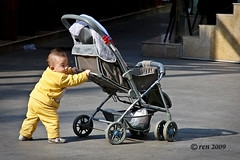In an article from Time, Michael Bruton writes about an experiment that took place at the university of Manchester that was set up to investigate and challenge current thinking on what young children do know and how they construct knowledge. According to the article, Daniel, a 9 year old was shown video clips of a train on a circular track. The train would disappear into a tunnel and reappear on the other side. There were hidden cameras recording Daniel’s eyes and measuring the diameter of his pupils at very high speed. The process was set up to measure the babie’s level of interest and attention spam. Whenever some novelty was introduced, he would register it and notice by becoming more alert.
In an attempt to understand children’s development, theorists have come with different explanations. “nativist” psychologists theorize that children are born already equipped with internal concepts about how the physical world. This idea can also be observed in the innatist prespective on first language acquisition. Noam Chomsky claimed that all human languages are fudamentally innate; He argued that children are biologically programmed to learn languages and that language develops in the child in just the same way that other biological functions. The study carried out at the baby lab mentioned in the Time article challenges this ‘nativist” view and supports the ideas of the Swiss pioneer Jean Piaget whose work led to the conclusion that development precedes learning. According to Piaget, Children construct knowledge through their interactions with the world.
Babylab director Sylvain Sirios has been challenging “Nativists” Beliefs and experiments.
How does my child learn two languages simultaneously? How does she make sense of the world and is able to make herself understood if only two years ago all she could do was cry? According to Piaget and Babylab director they have to through mental schema allowing them to make sense of the environment. Learning happens when facing situations or mental schemas cannot process. Our brain find disequilibrium. In an attempt to find balance the mind either assimilates the new piece of information or adapts by using new skills. Piaget called the process of assimilating new information to our schemas learning. In othe words, Children construct knowledge through their interactions with the world. Either way, a mother rests assured that her child will learn, and besides sitting and watching the magic take place, we, parents, should propose challenges and interact with our children as much as we can in order to help them develop as much as they can.
Learning Taking Place
In class we could:
Show the video and ask students to discuss what learning is.
Write the words: Motivation. strategies,automaticity, purpose, reward,investment, risk-taking, self-confidence, positive attitude, positive feedback. Ask students to find examples of these ideas in the video and how they can relate to learning a language.

No comments:
Post a Comment